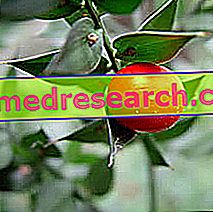
Scientific name
Ruscus aculeatus
Family
Liliaceae
Origin
Europe
Synonyms
Rusco, Butcher's Broom
Used Parts
Drug given by roots and rhizomes.
Chemical constituents
- Essential oil;
- Resin;
- Calcium salts;
- Potassium salts;
- steroidal saponins (among which ruscogenin stands out);
- Flavonoids;
- Phytosterols;
- Polyphenols;
- Tannins.
Butcher's Broom in Herbal Medicine: Properties of Butcher's Broom
Butcher's broom, as a standardized extract or as a decoction, is ideal for anti-inflammatory and anti-edema purposes.
In the cosmetic field, the dry extract is used for the vaso-protective activity of saponins in the treatment of skin, in intimate hygiene and in anti-cellulite adjuvants.
The most important biological activity of the holly rhizome is due to the steroid-type saponins which, due to their chemical structure, would exert an anti-inflammatory effect even superior to that of escin (Ippocastano).
Biological activity
Butcher's broom has anti-inflammatory, anti-edema, astringent and vasoprotective properties. More specifically, these actions are mainly attributable to the ruscogenin and flavonoids contained in it.
These activities have been confirmed by several studies that have been able to demonstrate how holly extracts - in particular, the ruscogenine contained in them - are able to play a protective role at the level of the microcirculation, reducing capillary fragility, and exercise a venotonic action reducing the stagnation of blood at the level of the legs.
An interesting study has also shown that the butcher's broom - thanks to its vasoconstrictor and venotonic action - has proved to be a potential remedy to counter orthostatic hypotension. However, further in-depth studies are still needed before we can approve a therapeutic application of this type of holly.
Butcher's bump against venous insufficiency and against hemorrhoids
As mentioned, thanks to the venotonic, vasoconstrictor and protective properties with regard to the microcirculation which the holly is equipped with, its use has obtained official approval for the treatment of disorders such as hemorrhoids, venous insufficiency and the symptoms associated with it, such as swelling, pain, itching, tingling and leg cramps.
As an indication, for the treatment of the aforementioned disorders, if the butcher's broom is used in the form of a liquid extract, it is usually recommended to take a quantity of product corresponding to about 7-11 mg of ruscogenin.
However, for more information on the therapeutic uses of butcher's broom and the doses normally used, see the article on "Treating with Butcher's Broom".
Butcher's broom in folk medicine and homeopathy
In folk medicine, butcher's broom is used - in combination with other plants - in preparations used to promote diuresis. Furthermore, the plant is used to lower blood pressure and to counteract edema and kidney stones.
Butcher's broom is also used in homeopathic medicine, where it can easily be found in the form of mother tincture, granules and oral drops.
In this context the plant is used in case of venous insufficiency, heavy legs, edema, phlebitis and circulatory disorders in general.
The amount of homeopathic remedy to be taken may vary from individual to individual, also depending on the type of disorder that needs to be treated and the type of homeopathic preparation and dilution that you want to use.
Watch the video
X Watch the video on youtubeSide effects
Signs and symptoms of gastric intolerance are rarely seen following the administration of butcher's broom.
Contraindications
Avoid taking holly and its preparations in case of hypersensitivity to one or more components. Furthermore, the use of the plant is also contraindicated in pregnancy and during lactation.
Pharmacological Interactions
- not known.



